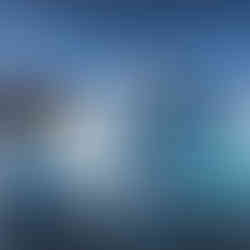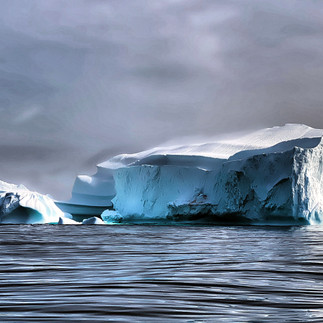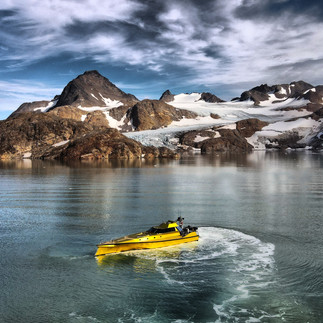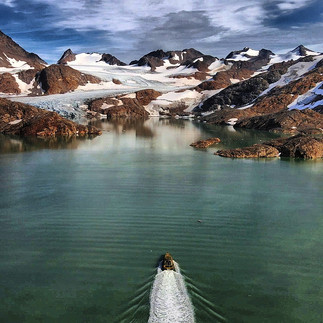Thunder Child II’s voyage to Greenland
- safehavenmarine
- Sep 12, 2021
- 11 min read
Updated: Jan 13, 2022
By Frank Kowalski

In August 2021 Thunder Child II lay in Reykjavik, Iceland after I and her crew returned to Ireland having completed our North Atlantic record run and Arctic Circle voyage in July. Bad weather had settled in across the North Atlantic preventing her voyage home at the time. Back in Ireland I couldn’t help but bemoan the fact that we had not been able to reach Greenland and the disappointment I felt as it was an ambition I had held for many years. At home in the evenings I could almost imagine standing on her deck in Iceland and seeing Greenland’s coast, as crazy as it might sound considering it was still 420 nautical miles away, but in my mind it appeared close. It had taken so much effort to get her to Iceland, I knew that if I bought her home she would most likely never get back there again, as it's just such a long, long way to get there from Ireland. So I made a decision that if a suitable weather window appeared in August, I would fly back to Iceland and try to get to Greenland this time, recounting the old adage that if at first you don't succeed, try again!
Back in July when we had tried to reach Greenland the first time during our arctic circle voyage from Northern Iceland, conditions were against us. There were two main reasons, firstly sea ice had not by then fully cleared off the East Coast of Greenland. My original planned destination of Tasiilaq was closed in by sea ice, forcing us to try and make the Blosseville Coast further north where there was a small break in the sea ice. Secondly the months of June and July are notorious for fog in the Denmark Strait and off the Greenland coast, in late August and September the likelihood of fog decreases. On this occasion we hit the sea ice edge 30 miles from the coast in heavy zero visibility fog, and it was just too dangerous to continue further and try to reach the coast, forcing us to abandon the attempt. Luckily, indeed a suitable weather window appeared and on the 12th of August I flew back to Iceland. For this voyage my usual crew could not make it due to work commitments, so only myself and Kenny Carroll, who would be my engineer and works for me at Safehaven Marine flew out. Kenny had been disappointed to miss our first voyage as at the time was still awaiting his second vaccine jab, and as such not fully vaccinated like the rest of the crew. Luckily, through friends I had made in Iceland I managed to take aboard two Icelandic crew, Siggeir Palsson and Alex Oddsson in Reykjavik. Although I was prepared to undertake the voyage with just Kenny and myself, it would have been hard going on such a long passage with just the two of us.
Below, map showing Thunder Child II's 4,000 mile voyage.

On the evening of the 12th we cast off from Reykjavik. My plan was to get the 5 hours of night passage done relatively close to Iceland, so that by the time we closed the waters off Greenland where we might begin to encounter Icebergs, we would be in daylight hours. Greenland’s waters are considered so dangerous due the presence of icebergs and fog that a voyage plan has to be notified to the Greenland Coastguard in advance of any vessel entering its waters 200nm from the coast. The Coastguard must also be updated every six hours as to one’s position, sea and ice conditions and current situation. We did this by relaying massages via satellite communication devices aboard to Mary at our shore base in Ireland. Mary then communicated our information by e mail to the Coastguard. We also provided a link to our live tracking web portal created by Safetrx so they could track our progress throughout our time in Greenland waters. The first 100 miles or so were a bit tough going with a Force 5 wind off our bow, and heavily loaded with fuel we were just making 22kts into the weather. However as forecasted by Windy, (which again proved to be incredibly accurate with its forecasts, at least up to 3 days out), the wind died off, and for the remaining 200 miles we had no wind and a calm sea, with just a swell behind us allowing us to run at over 30kts. Thankfully the dreaded fog stayed mostly away, with us only encountering a few banks of fog throughout the voyage which slowed our progress at times. When 65 miles from Tasiilaq and 50 miles off the nearest coast of Greenland we came upon the first icebergs. These were huge icebergs and awe inspiring, floating like giant sentinels alone in the ocean out of sight of land. It’s always a fabulous moment when you come across your first icebergs on a voyage, so the moment was celebrated by a brew as we drifted peacefully in silence, with Thunder Child’s four engines themselves enjoying a break, as we admired the majesty of the icebergs.

Encountering our first iceberg, a giant floating like a sentinel in the sea as we voyaged across the Denmark Strait, some 65nm from Tasiilaq and 50nm off the coast. Icebergs this size were clearly visible on radar, smaller ones not so much and small growlers not at all.
Thereafter as we headed to Tasiilaq the icebergs became increasingly more frequent until as we approached the coast they were everywhere you looked out to the horizon. Finding the entrance to the bay that led up to the town of Tasiilaq was not easy, as the entrance was quite narrow and crowded with icebergs. We also had a degree of trepidation as to the accuracy of our ECDIS nautical charts, as only a very small area of Greenland is accurately mapped due to the regions remoteness. As it turned out the small square of detailed chart around Tasiilaq proved to be very well mapped. However, as we later discovered this was not the case for the surrounding coastline, as at one point during our voyaging along the coast we found our self’s shown to be crossing right over the top of a small island on the chart plotter, when in actual fact we were a few hundred yards off it. Running up the fjord to the town was wonderful, with clear skies and sunshine, with numerous smaller icebergs aground by the shoreline, it really was a picturesque sight. The town of Tasiilaq has a population of 1700 people and is the largest settlement on the East Coast of Greenland, apart from the small settlement of Kulusuk just up the coast, the nearest town to the south is Nanortalik, 400 miles away and 500 miles to the North is Ittoqqortoormiit in Scoresby Sund. The coast line between being completely uninhabited, which shows both the vastness and remoteness of the region. Upon arrival at the single commercial quay where the weekly supply ship berths we were met by the ports harbourmaster, and once the expected formalities of immigration and of course in our current times, verification of our Covid vaccination passports and negative PCR tests had been completed, we were allowed ashore. Kindly the Harbour Master allowed us to stay alongside the commercial quay until Sunday, when the ship was due to arrive. Before it arrived we would have to anchor Thunder Child in the bay, which we had anticipated, but it was more convenient to be able to stay alongside the quay. Needless to say Thunder Child II’s unique looks and her gold livery created quite a stir, (as she would do everywhere she went) amongst the small population drawing many visitors to the quay to see her, all of whom were very friendly and helpful. During our visit we stayed at the Hotel Angmagssalik, which was very comfortable and hospitable to us.

Above, Thunder Child II anchored in the bay off Tasiilaq, in winter months the bay would freeze over.
After a good night’s rest, which was well needed, as at this point I hadn’t really had any sleep for 2 days as Thursday night was spent travelling by car, and Friday night was spent at the helm during the crossing from Iceland, which incidentally took approximately 17hrs to make the 420nm across the Denmark Strait. Our plan for Saturday was to head South to the large Sermilik Fjord and then on to the Johan Peterson Fjord at the end of which lay the Bruckner and Heim glaciers. As we travelled along the coastline towards Sermilik Fjord we came upon an abundance of icebergs at the mouth of the fjord and the surrounding sea, I described the sight at the time as ‘the iceberg factory’ where the icebergs were exciting the fjord and drifting out to sea.

Above. Some of the icebergs we encountered were truly massive, almost like city blocks floating in the sea.
As we approached the density of growlers and small pieces of ice increased dramatically calling for constant course changes and great vigilance. The smaller growlers and pieces of floating ice could be very hard to see if there was any swell running or if you were heading into the sun, where reflections in the water looked much the same as small pieces of ice. Sometimes in the calm seas within the fjords one would come across an unbroken line of small pieces of sea ice caused by a tidal eddy. There would often be no way around and the only solution was to come slowly up to the line of ice and just before it take the engines out of gear and let her drift slowly through at about 1kt. Thunder Child II’s FRP hull sure as hell wasn’t built for going through any kind of heavy ice and her four surface piercing propellers were particularly vulnerable. But with this method there was no issue as the small pieces of ice passed gently down her side, and after initially swirling around the transom would clear allowing you to continue on. Throughout our time in the waters around Greenland we were extremely careful and we never hit any ice, as the consequence of damaging Thunder Child’s hull in such a remote region would have been dire to say the least, as there was no facility to lift her out or even beach her, and in just a couple of months’ time the waters would begin to freeze and the area would again become locked in ice. There are different types of ice in Greenland, we saw mostly icebergs of young white ice calved from the ice shelf and glaciers, with only the occasion blue iceberg formed from old ice. There were also many floating ice sheets that had either broken off the ice shelf in the Arctic and drifted down, or remained from the winter’s ice sheet that formed in the Fjords. The most dangerous, at least for us in a small boat was black ice. Black ice is formed from rainwater that congregated in crevasses and froze, the black ice growlers are the most dreaded by Greenlanders as they float almost completely submerged and are transparent. Locally referred to as liquid stones they are very difficult to spot and would put a hole in the hull pretty damn quick if hit at speed.

When travelling around the icebergs, of which we did a lot of flying our drone and capturing our imagery, one had to be very careful. Some 90% of an iceberg is hidden under the water and one could easily get caught out as often the iceberg would extend far out from the visible part one could see. To a certain extent on a sunny day you could see this at sea level from a boat as a light bluish area of sea. However it was only from high up that you could see this clearly, and from our drone we could see the full extent of the iceberg and judge where we could safely go. For the most part icebergs are stable and the larger ones can last 2-3 years, however they are undergoing a continuous process of melt, and erosion from waves. As such at various points in their lifespan they can become fragile and parts can break off unexpectedly causing the iceberg to become unstable. Should we have been too close to an iceberg when this happened there was a very real risk that the iceberg could suddenly capsize and roll over on top of Thunder Child II before she could get out of the way.

Above, moving slowly out of gear through one of the lines of small sea ice that formed in tidal eddies.
As we travelled up the Sermilik Fjord the density of growlers and small pieces of ice gradually increased to the point when it was becoming increasingly difficult to find a path through them, and I felt that if we continued on to try and reach the Johan Peterson Fjord it could become dangerous, as there would come a point when it would become impossible to turn or manoeuvre Thunder Child without inevitably coming in to contact with ice.

Above, heading up the Sermilik Fjord dodging icebergs and growlers to try and reach the glaciers at the end.
To compound the situation, as we left Tasiilaq fog was beginning to come in towards the land from offshore, and as we looked back it appeared to be entering the mouth of the Fjord. Often fog forms in the cold waters just off the land but doesn’t actually reach over the shore due to the heat coming off the land, but not always. If we had travelled any further and fog had come down on us we would have been in real trouble as it would have been almost impossible to navigate through such a high density of ice in fog, as you wouldn’t be able to see to plot a path ahead, and one would inevitably come into contact with ice. So I decided to not take any chances and head back out of the Fjord. As it happened the fog never came in any further, but in this case discretion was the better part of valour. Arriving back to Tasiilaq that evening we had a pleasant evening at the hotel talking with the other residents, all whom had interesting stories to recount about Greenland.
On Sunday the ship was scheduled to arrive, so in the morning we moved Thunder Child off the commercial quay and put her at anchor in the bay. She looked both beautiful and incongruous glistening like a bar of gold in the evening sunlight. Anchoring her was not easy as the fjord is very deep, a relatively shallow shelf ran out a few hundred metres from the shore at a depth of 20m before quickly falling to a depth of 100m. With only 90m of chain and warp it was challenging to drop the anchor in a position where she was safely clear of the shore, but not so close to the edge of the shallow water shelf that were the anchor to drag, it would pull over the shelf into the deep water, at which point she would become adrift as the depth of water exceeded the scope of warp. When we anchored the wind was onshore, but during the night it swung to offshore and increased in strength causing me a few hours of anxiousness as I looked out from my hotel room worrying whether the anchor would drag. I spent a couple of hours trying to calculate on my Navionics app where she would drift to and where the anchor might take hold again if it broke out. Thankfully it held fast.

Above, heading up towards the glacier by Kulusuk Island, the area was not well charted so care was needed.
On Monday we headed North along the coast to the small settlement of Kulusuk with its population of 200 people. Just North of Kulusuk Island we were informed was a smaller glacier that could be reached by boat, so this was to be our destination as I was determined to get to a glacier. And indeed we did reach it, lying between two mountains the glacier meandered down to meet the waters at the edge of its fjord, allowing us to get close to it and fly our drone out over the glacier to capture some wonderful footage of its jagged ice that had been travelling down from the ice cap for thousands of years.
Returning to Tasiilaq that evening and with the ship departed, we were able to again lay alongside at the quay and take on fuel for our return voyage to Iceland. Departing the next morning at 6am we had calm seas for the first half of the voyage eventually catching up with the tail end of a low pressure system that had passed south of Iceland the day before which put a 2-3m following swell behind us. After a 20hr passage we arrived in Reykjavik at dawn on Wednesday, where we would await the arrival of Carl and Mary to help bring Thunder Child II home to Ireland with Kenny and myself, this time via the Faroe Islands.
Eventually Thunder Child II would have travelled nearly 4,000 miles and looked after us in some of the most dangerous and inhospitable seas in the World, she had done us proud, and although at times it was a bit hairy navigating through the sea ice and icebergs, and being so far from land crossing the North Atlantic and especially the Denmark Strait, it was worth every minute and an experience I will never forget, and undertaken in the remarkable boat Thunder Child II is.

VIDEO
PHOTOS































































